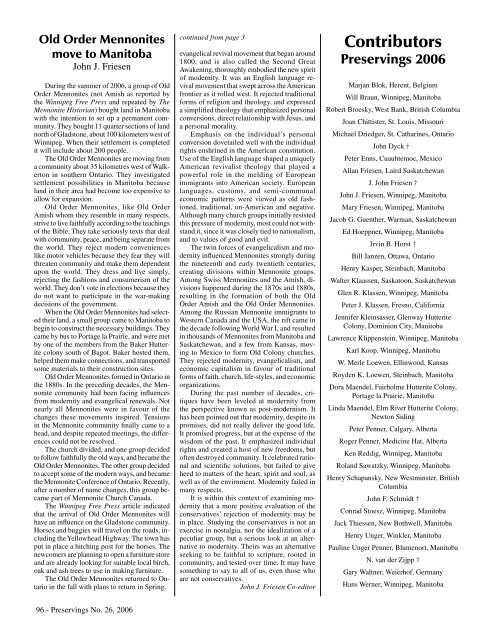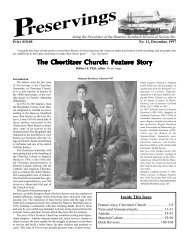Preservings $20 Issue No. 26, 2006 - Home at Plett Foundation
Preservings $20 Issue No. 26, 2006 - Home at Plett Foundation
Preservings $20 Issue No. 26, 2006 - Home at Plett Foundation
You also want an ePaper? Increase the reach of your titles
YUMPU automatically turns print PDFs into web optimized ePapers that Google loves.
Old Order Mennonites<br />
move to Manitoba<br />
John J. Friesen<br />
During the summer of <strong>2006</strong>, a group of Old<br />
Order Mennonites (not Amish as reported by<br />
the Winnipeg Free Press and repe<strong>at</strong>ed by The<br />
Mennonite Historian) bought land in Manitoba<br />
with the intention to set up a permanent community.<br />
They bought 11 quarter sections of land<br />
north of Gladstone, about 100 kilometers west of<br />
Winnipeg. When their settlement is completed<br />
it will include about 200 people.<br />
The Old Order Mennonites are moving from<br />
a community about 35 kilometres west of Walkerton<br />
in southern Ontario. They investig<strong>at</strong>ed<br />
settlement possibilities in Manitoba because<br />
land in their area had become too expensive to<br />
allow for expansion.<br />
Old Order Mennonites, like Old Order<br />
Amish whom they resemble in many respects,<br />
strive to live faithfully according to the teachings<br />
of the Bible. They take seriously texts th<strong>at</strong> deal<br />
with community, peace, and being separ<strong>at</strong>e from<br />
the world. They reject modern conveniences<br />
like motor vehicles because they fear they will<br />
thre<strong>at</strong>en community and make them dependent<br />
upon the world. They dress and live simply,<br />
rejecting the fashions and consumerism of the<br />
world. They don’t vote in elections because they<br />
do not want to particip<strong>at</strong>e in the war-making<br />
decisions of the government.<br />
When the Old Order Mennonites had selected<br />
their land, a small group came to Manitoba to<br />
begin to construct the necessary buildings. They<br />
came by bus to Portage la Prairie, and were met<br />
by one of the members from the Baker Hutterite<br />
colony south of Bagot. Baker hosted them,<br />
helped them make connections, and transported<br />
some m<strong>at</strong>erials to their construction sites.<br />
Old Order Mennonites formed in Ontario in<br />
the 1880s. In the preceding decades, the Mennonite<br />
community had been facing influences<br />
from modernity and evangelical renewals. <strong>No</strong>t<br />
nearly all Mennonites were in favour of the<br />
changes these movements inspired. Tensions<br />
in the Mennonite community finally came to a<br />
head, and despite repe<strong>at</strong>ed meetings, the differences<br />
could not be resolved.<br />
The church divided, and one group decided<br />
to follow faithfully the old ways, and became the<br />
Old Order Mennonites. The other group decided<br />
to accept some of the modern ways, and became<br />
the Mennonite Conference of Ontario. Recently,<br />
after a number of name changes, this group became<br />
part of Mennonite Church Canada.<br />
The Winnipeg Free Press article indic<strong>at</strong>ed<br />
th<strong>at</strong> the arrival of Old Order Mennonites will<br />
have an influence on the Gladstone community.<br />
Horses and buggies will travel on the roads, including<br />
the Yellowhead Highway. The town has<br />
put in place a hitching post for the horses. The<br />
newcomers are planning to open a furniture store<br />
and are already looking for suitable local birch,<br />
oak and ash trees to use in making furniture.<br />
The Old Order Mennonites returned to Ontario<br />
in the fall with plans to return in Spring.<br />
continued from page 3<br />
evangelical revival movement th<strong>at</strong> began around<br />
1800, and is also called the Second Gre<strong>at</strong><br />
Awakening, thoroughly embodied the new spirit<br />
of modernity. It was an English language revival<br />
movement th<strong>at</strong> swept across the American<br />
frontier as it rolled west. It rejected traditional<br />
forms of religion and theology, and expressed<br />
a simplified theology th<strong>at</strong> emphasized personal<br />
conversions, direct rel<strong>at</strong>ionship with Jesus, and<br />
a personal morality.<br />
Emphasis on the individual’s personal<br />
conversion dovetailed well with the individual<br />
rights enshrined in the American constitution.<br />
Use of the English language shaped a uniquely<br />
American revivalist theology th<strong>at</strong> played a<br />
powerful role in the melding of European<br />
immigrants into American society. European<br />
languages, customs, and semi-communal<br />
economic p<strong>at</strong>terns were viewed as old fashioned,<br />
traditional, un-American and neg<strong>at</strong>ive.<br />
Although many church groups initially resisted<br />
this pressure of modernity, most could not withstand<br />
it, since it was closely tied to n<strong>at</strong>ionalism,<br />
and to values of good and evil.<br />
The twin forces of evangelicalism and modernity<br />
influenced Mennonites strongly during<br />
the nineteenth and early twentieth centuries,<br />
cre<strong>at</strong>ing divisions within Mennonite groups.<br />
Among Swiss Mennonites and the Amish, divisions<br />
happened during the 1870s and 1880s,<br />
resulting in the form<strong>at</strong>ion of both the Old<br />
Órder Amish and the Old Order Mennonites.<br />
Among the Russian Mennonite immigrants to<br />
Western Canada and the USA, the rift came in<br />
the decade following World War I, and resulted<br />
in thousands of Mennonites from Manitoba and<br />
Sask<strong>at</strong>chewan, and a few from Kansas, moving<br />
to Mexico to form Old Colony churches.<br />
They rejected modernity, evangelicalism, and<br />
economic capitalism in favour of traditional<br />
forms of faith, church, life-styles, and economic<br />
organiz<strong>at</strong>ions.<br />
During the past number of decades, critiques<br />
have been leveled <strong>at</strong> modernity from<br />
the perspective known as post-modernism. It<br />
has been pointed out th<strong>at</strong> modernity, despite its<br />
promises, did not really deliver the good life.<br />
It promised progress, but <strong>at</strong> the expense of the<br />
wisdom of the past. It emphasized individual<br />
rights and cre<strong>at</strong>ed a host of new freedoms, but<br />
often destroyed community. It celebr<strong>at</strong>ed r<strong>at</strong>ional<br />
and scientific solutions, but failed to give<br />
heed to m<strong>at</strong>ters of the heart, spirit and soul, as<br />
well as of the envirnment. Modernity failed in<br />
many respects.<br />
It is within this context of examining modernity<br />
th<strong>at</strong> a more positive evalu<strong>at</strong>ion of the<br />
conserv<strong>at</strong>ives’ rejection of modernity may be<br />
in place. Studying the conserv<strong>at</strong>ives is not an<br />
exercise in nostalgia, nor the idealiz<strong>at</strong>ion of a<br />
peculiar group, but a serious look <strong>at</strong> an altern<strong>at</strong>ive<br />
to modernity. Theirs was an altern<strong>at</strong>ive<br />
seeking to be faithful to scripture, rooted in<br />
community, and tested over time. It may have<br />
something to say to all of us, even those who<br />
are not conserv<strong>at</strong>ives.<br />
John J. Friesen Co-editor<br />
Contributors<br />
<strong>Preservings</strong> <strong>2006</strong><br />
Marjan Blok, Herent, Belgium<br />
Will Braun, Winnipeg, Manitoba<br />
Robert Broesky, West Bank, British Columbia<br />
Joan Chittister, St. Louis, Missouri<br />
Michael Driedger, St. C<strong>at</strong>harines, Ontario<br />
John Dyck † <br />
Peter Enns, Cuauhtemoc, Mexico<br />
Allan Friesen, Laird Sask<strong>at</strong>chewan<br />
J. John Friesen †<br />
John J. Friesen, Winnipeg, Manitoba<br />
Mary Friesen, Winnipeg, Manitoba<br />
Jacob G. Guenther, Warman, Sask<strong>at</strong>chewan<br />
Ed Hoeppner, Winnipeg, Manitoba<br />
Irvin B. Horst †<br />
Bill Janzen, Ottawa, Ontario<br />
Henry Kasper, Steinbach, Manitoba<br />
Walter Klaassen, Sask<strong>at</strong>oon, Sask<strong>at</strong>chewan<br />
Glen R. Klassen, Winnipeg, Manitoba<br />
Peter J. Klassen, Fresno, California<br />
Jennifer Kleinsasser, Glenway Hutterite<br />
Colony, Dominion City, Manitoba<br />
Lawrence Klippenstein, Winnipeg, Manitoba<br />
Karl Koop, Winnipeg, Manitoba<br />
W. Merle Loewen, Ellinwood, Kansas<br />
Royden K. Loewen, Steinbach, Manitoba<br />
Dora Maendel, Fairholme Hutterite Colony,<br />
Portage la Prairie, Manitoba<br />
Linda Maendel, Elm River Hutterite Colony,<br />
Newton Siding<br />
Peter Penner, Calgary, Alberta<br />
Roger Penner, Medicine H<strong>at</strong>, Alberta<br />
Ken Reddig, Winnipeg, Manitoba<br />
Roland Saw<strong>at</strong>zky, Winnipeg, Manitoba<br />
Henry Schapansky, New Westminster, British<br />
Columbia<br />
John F. Schmidt †<br />
Conrad Stoesz, Winnipeg, Manitoba<br />
Jack Thiessen, New Bothwell, Manitoba<br />
Henry Unger, Winkler, Manitoba<br />
Pauline Unger Penner, Blumenort, Manitoba<br />
N. van der Zijpp †<br />
Gary Waltner, Weierhof, Germany<br />
Hans Werner, Winnipeg, Manitoba<br />
96 - <strong>Preservings</strong> <strong>No</strong>. <strong>26</strong>, <strong>2006</strong>
















